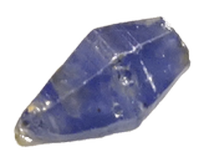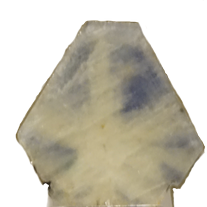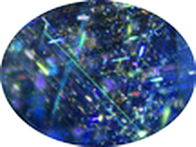The Sapphire in The Wall of The Heavenly Jerusalem
The Sapphire in The Wall of The Heavenly Jerusalem
Sapphire belongs to the mineral class of oxides, the chemical formula of the mineral ist Al2O3 . The blue-colored variety is called sapphire and the red-colored variety is called ruby, both belong to the group of corundum.
Origin of the word: The name sapphire comes from the Greek and means "blue". Based on this definition, we can assign its color to the sky. The Messiah, Jesus of Nazareth, descended from heaven, as it is said in Proverbs 30:4. But just as the Son of God is heavenly in nature, so are the raptured believers. The sapphire speaks of both Jesus and His bride. The Hebrew term sapphire -ספיר - is mentioned eleven times in the Tanakh, the Old Testament. In the New Testament, we find the stone only once. When in a literary work a word or linguistic expression occurs only once, experts speak of a hapax legomenon and is translated as " is said once". Each hapax legomenon, as we have noted, points to the end times. And so the Greek word Sappheiros - in capital letters ΣΑΠΦΕΙΡΟΣ - must have something to do with the last days before the visible return of Jesus.
Note: The sapphire is in no way a lapis lazuli, as certain people claim. (We go into it further below with good arguments for the sapphire). Furthermore, opinions circulate to the effect that the sapphire would not have any inclusions that could describe the celestial character. But see, the sapphire shown by us under second has a star. Also, there are other sapphires that are quite rare, but they can be found that have characteristics that fit the biblical description perfectly. For this purpose we also refer to the website Steine und Minerale.de or minerals.net, because there is not speculated, but explained technically simple and understandable for every layman:
The transparency of sapphires is transparent to translucent. The luster is glassy or diamond-like, sometimes silky due to the minerals embedded in the crystal, such as the fine rutile needles, these inclusions also cause the so-called asterism of sapphires, which are expressed in the form of a six-rayed star. Ingrown rutile needles cross each other.
 1. Sapphire in the mother rock |  4. Sapphire - Sri Lanka |
 2. Sapphire - Queensland Australia |  5. Sapphire with disordered rutile needles *1 |
 3. Corrund group |
*1 Regarding image 5: This is a multiple enlargement so that the inclusions can be clearly seen.
Prophetic meaning of the sapphire
We have already explained that the name derives from the Greek and means blue. Now let's look at the Hebrew word origin of Sapphairos and it is Sappir - ספיר. It is a stone that can be used for carving, because the word root of Sappir is sapar - ספר - and has the following meanings:
- to notch with a character, as in a tally sheet or record;
- to inscribe, to count, to count through (whether all are there);
- reinforcing also: to recount, to count again; to commit festively.
With a Lapis lazuli nothing can be notched, but also really nothing, because with the Mohs hardness of 5.5 it is much too soft. The sapphire has a Mohs hardness of 9, which means that any metal can be carved with such a stone. The word root points to the Messiah who counts the full number of the nations, yes, he repeats the counting by making a feast out of the repetition of his counting. Isn't this a lovely image. How much the Lord must look forward to this day. Let us also rejoice.
The Sapphire in the Bible
In Exodus 24, 10 Moses, Aaron, Nadab and Abihu climb the mountain with 70 elders. Only Moses is allowed to approach God, the others stand from a distance to worship. Verse 10, which is not so easy to understand, speaks of sapphire stones (not sapphire plates). Only in the literal translation, with all its variations, can the puzzle be guessed at. Can the puzzle be solved? Let's take a closer look at a few words:
- tachat
- regel
- ma-aseh
- livnah
- sappir
- etzem
- shamayim
- tohar
| Transliteration | Hebrew | Meaning | derived meaning | derived meaning | result |
tachat | תחת | ground, base | under, below | instead of | |
regel | רגל | foot, while running | a step | ||
ma-aseh | מעשה | Plot | implementation, settlement | activity | property, poem |
livnah | לבנה | White | transparency | be white | make stones |
sappir | ספיר | sapphire | carve | enroll | to celebrate |
etzem | עצם | Bone; Body; substance simila | bind tightly, shut down (of eyes) | to be powerful; be numerous | crush bones |
shamayim | שמים | heaven | sublime | elevated | high |
tohar | טוהר | luminosity; Clarity; Shine; splendor; cheerfulness; Purity; | to be bright; to be pure; innocent; holy | ||
The interpretation of the sapphires of Exodus 24, 10
And there went up Moses and Aaron, Nadab and Abihu, and seventy of the elders of Israel; and they saw the God of Israel; and under his feet it was as a work of sapphire stones, and as the heavens themselves in clearness.
If the 74 men see the God of Israel, it can only be the Son. Comparisons are made in the text by means of figurative language:
under his feet like sapphire stones;
a work like sapphire stones;
like the sky in clarity.
A clear sky is without clouds and the sun shines in its splendor. The image of the clear sky is more accurately described by the word root "tohar". The sky is bright and pure, and further, it is said to be innocent and holy. Guilty can be only two groups of people, there are on the one hand the people and on the other hand the fallen angels. In this place everything is pure and so Moses and the others worship 73 there. Thus the sapphire stones point to a heavenly sanctuary. The Hebrew word etzem, which stands for bones, body and like texture, is not actually translated. But if one understands that here a "body" was formed from sapphire stones, then it must be the wall of the heavenly sanctuary. The word work, as translated in the Elberfelder, describes what God has done and how He has done it. The work is his "property" that he poetically describes in a poem.
How did the wall come into being? The word "livnah" expresses it with the words "to be white" and "made into stones". God has made us living white stones through the rebirth. The apostle Peter writes about this when he mentions the kind of stones: be yourselves also, as living stones, built up, a spiritual house. The problem of the addressees: they are not yet born again and have not yet overcome. They are dead and dead stones are not inserted into the heavenly sanctuary.
A house in this sense refers not only to the building itself, but also to the outer area, which is enclosed by a wall. In other words, it is the courtyard with its wall. This wall is seen by Aaron, Nadab, Abihu and the seventy elders.
The interpretation of the sapphire from Job 28:
Its rock is the seat of the sapphire, and gold steps in it.
Literally, the text reads:
The sapphire place, stones and gold dust in them.
The place of the stones is in the earth. When verse 7 says: A path that the bird of prey does not know, and that the eye of the hawk has not beheld, the path speaks of the mysterious time of the bride and bridegroom getting to know each other. Just as it is said in Proverbs 30:10, the speaker in Job 28:7 also refers to the hidden path. And because sapphires are mentioned, which symbolize the heavenly, they point to the heavenly origin of bridegroom and bride.
The mineral gold dust, which are the disordered rutile needles in the sapphire, see above Fig. 5, reflect the incident light in many colors. If the rutile needles are ordered, a six-rayed white star appears, which, if you move the stone back and forth, seems to wander. It is different with lapis lazuli. It is not classified as a mineral, but as a rock. Light does not penetrate into it to reflect a play of colors. We can move it back and forth, its appearance remains unchanged.
| LINK | Property |
| Jasper | opaque | |
Sapphire | transparent | |
Chalcedony | opaque | |
Samaragd | transparent | |
Sardonix | Sardonix | opaque |
Sardis | Sardis | opaque |
Chrysolite | Chrysolite | translucent |
Beryl | Beryl | transparent |
Topaz | Topaz | translucent/transparent |
chrysoprasm | chrysoprasm | opaque |
Hyacinth | Hyacinth | transparent |
Amethyst | Amethyst | transparent |
P.S.: We recommend the TOR browser because it makes surfing safer and the DuckDuckGo.com search engine because it actually shows more and better search hits.







